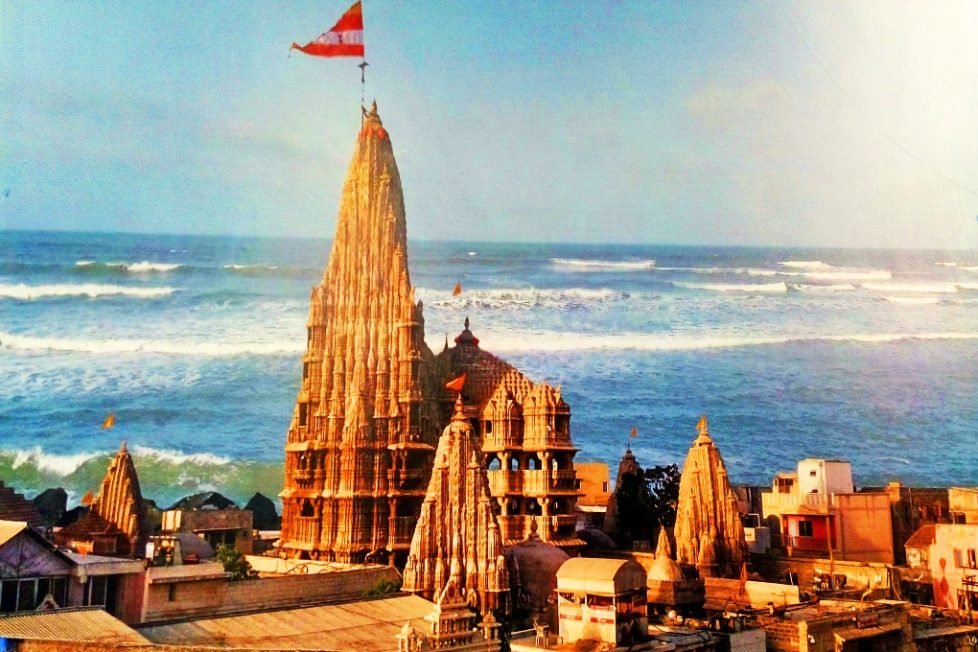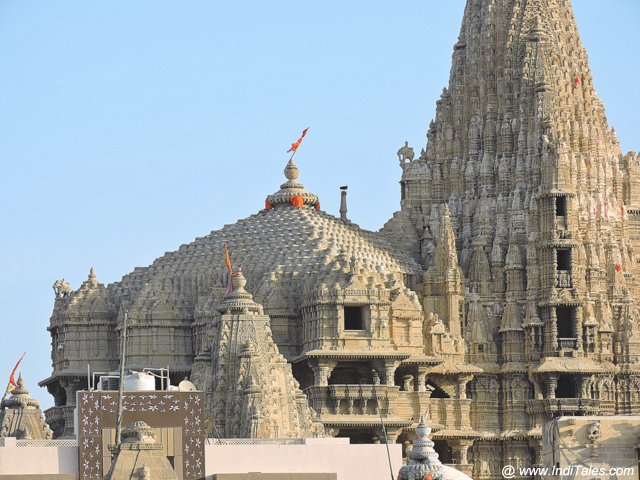JAGAT MANDIR- DWARKA


THE UNIVERSAL ELEGANCE
Krushna Patel
The main draw for tourists coming to Dwarka, the Dwarkadhish Temple (Jagat Mandir), is believed to have been established more than 2500 years ago by Lord Krishna’s great-grandson, Vajranabh. The ancient temple has been renovated several times, especially leaving imprints of the 16th and 19th centuries. The temple stands on a small hill accessed by 50 plus steps, with heavily sculptured walls that cocoon the sanctum with the main Krishna idol. Around the complex lie other smaller shrines. The walls have intricately carved Vedic characters and legends. The impressive 43 m high spire is topped with a flag made from 52 yards of cloth that flutters in the soft breeze from the Arabian Sea behind the temple. There are two doors (Swarg and Moksh) for the entry and exit of the temple. A bridge called Sudama Setu, at the base of the temple, takes one across the Gomti creek towards the beach.
Dwarka on the western tip of the Kathiawar Peninsula is clubbed with the holiest sites in India – the Char Dhams that include Badrinath, Puri, and Rameshwaram. It is believed that Lord Krishna arrived here from Braj in Uttar Pradesh to build the city. The temple was established by his grandson. It is at the cusp of the Gomti River and the Arabian Sea, providing a scenic backdrop to the spiritual site. It is said that Dwarka was submerged under the sea six times and what we see now is its seventh avatar. The temple itself has a fascinating legend. The original structure was destroyed by Mahmud Begada in 1472 and subsequently rebuilt in the 15th-16th century. It was also feted by Adi Shankaracharya, the 8th-century Hindu theologian, and philosopher.
The temple is built of soft limestone and consists of a sanctum, vestibule (entrance), and a rectangular hall with porches on three sides.
There is a vibe of celebration all around. The temple and Dwarka are full of Shringar Ras.
Dwarka of Dwarvati an ancient port is considered the gateway of India. Its Antiquity goes back to the Mahabharat period. Dwarka was established by Lord Krishna to protect Yadavas from Jarasandh’s annoy and attack. It was constructed on the remains of Kushasthali which was built by King Revant.
Small-scale excavations reveal that the history of Dwarka goes back to around 2000 years. There was maritime trade, contact of India with ancient Rome during the early Christian era which was witnessed during excavation at Dwarka. But painted pot-shreds found from Bet-Dwarka or Shankhoovar belongs to Harappan culture. (1900 – 1500 BC) which means the habitation belongs to more than 4000 years old. It was the gateway of western India as well as India by the way of the sea route. old Dwarka, presently found near Bet Dwarka under the Arabian sea.
There are various temples like Veni-Mahadev, Purushottamji, Devakiji, and Sharada peetha of Adi Shree Shankaracharya in the complex of Dwarkadhish temple. Here acharya like Madhavacharya, Vallabhacharya, and saint-like Narsinh Mehta and Mirabai also visited this place as a pilgrim. Even today the flow of the pilgrims and their presence show the importance of the Dwarkadhish temple built during the 8th – 10th Century AD present temple of Dwarkadhish is built-in style and plan of Chalukyas dynasty of Gujarat, belongs to 15th – 16th Century AD which consists of Garbhagriha, Antarala, Sabhamandapa and entrance porch.
It covers 27mts * 21mts. The area and the height of Shikhara are 51.8 mats. The mandapa is having 72 decorative pillars. The temple is having 5 floors. Every floor has a projected balcony with a decoration of animal as well as floral motifs. In the temple complex addition and alteration has been done in the later period.
Dwarkadhish Temple is also home to one of the 4 Shankaracharya Peethas – Sharda Peetha. The other three are Jyotish Math at Badrinath, Sringeri Math in Karnataka, and Govardhan Math in Puri in Odisha. Sharda Peeth part of the temple is a new construction dedicated to Adi Shankaracharya. In the mornings and evenings, you can see hear the students chanting Vedic chants in Sanskrit. Of the 4 Vedas, Dwarka’s Sharda Peeth has Saam Veda, and you can hear its chanting.
Just like the Dwarkadish Temple at Bet Dwarka, the Dwarkadish temple at Gomti Dwarka is also full of big and small temples. In the Sanctum sanctorum of the Garbha Griha sits the image or murti of Krishna as four-armed Vishnu. Experts call it the form of Trivikram.


As you enter from the Moksha dwar on your right you see:
The giant or the Bhavya temple stands an elevation of about 80 meters or 250 feet making it as tall as a 25-story modern-day building. On top of it is 25 ft long flagstaff.

The towering Shikhara over the Garbha Griha is built in a Nagara Style replicating a mountain peak. There are 7 stories visible and the Pandit guiding me attributes it to Dwarka being one of the 7 ancient cities or Sapta-Puris of India. The seven cities being Ayodhya, Mathura, Maya, Kashi, Avantika, Kanchipuram, and Dwarka. Each Story represents a Puri with the bottom one representing the Dwarka. Looking at all the stories in one frame is like watching the whole of India represented in the temple.

The temple has two entrances – north and south called Moksha Dwar and Swarg Dwar. If you understand the words Moksha and Swarg you will enjoy the names of the two doors. When you die you either want to be liberated from the cycle of birth and death or get Moksha or you want to be in Swarg or heaven where you get to live the best possible life and the Indian word for that would be Bhog. There are 56 steps on the Swarg Dwar side that lead to the temple from the Gomti Ghats. Some oral stories say that those 56 steps represent 56 Koti or 56 Crore Yadavas, but I wonder if the population was so much.
Dwarkadish Temple follows a strict daily routine with many rituals throughout the day. There are aartis, there are darshans and there are bhogs. The activities mean worshipping the deities, opening up the doors to let the devotees converse with the deity, and offering the food to the deity.
All through the day, the Shringar of the deity is changed. The dress changes, the backdrop changes, the jewelry changes and the deity has a new look every time the devotees visit him. On special days, the Shringar is even more elaborate.
Wherever you look at the Dwarkadish temple, you can not miss the huge fluttering flag on top of its Shikhara. You would also notice that there is a different flag every time you look at the temple. Well, the flag is changed 5 times a day – thrice in the morning hours and twice in the evening. It is not just a change of flag, it is a huge ceremony. The family sponsoring the flag feeds all the Brahmins of Dwarka followed by elaborate Puja. They bring the flag to the temple singing and dancing, carrying it on their heads. The flag is offered to the deity after which a member of the Brahmin community goes up and changes the flag.

There is a waiting period of 2 years if you want to sponsor a flag change.
The flag measures 52 yards or 40 meters – yes, it is a huge flag. 52 smaller flags are attached to the large flag representing the 52 officers of Dwarka or 52 sub-castes of Yadavas. Another theory says 52 represents the 12 zodiac signs, 27 Nakshatras, 10 directions, Sun, Moon & Sri Dwarkadish. Yet another theory says that it represents the 52 doors that Dwarka had once upon a time. Remember, it was also called Dvaravati, or the city of beautiful doors. The flag can be any color or a combination of colors except the black color. The flag has an emblem of the sun and moon on it.
All the rituals and ceremonies of Dwarkadhish Temple are done by Guggali Brahmins. It is believed that Sri Krishna himself brought these Brahmin families to Dwarka.
The temple itself has a fascinating legend. The Dwarkadhish temple in Gujarat is an epitome that glorifies Indian history, Indian architecture, Indian rituals and signifies and dignifies the Indian glory of temples and the human lives at large.
DISCLAIMER: The author is solely responsible for the views expressed in this article. The author carries the responsibility for citing and/or licensing of images utilized within the text.
